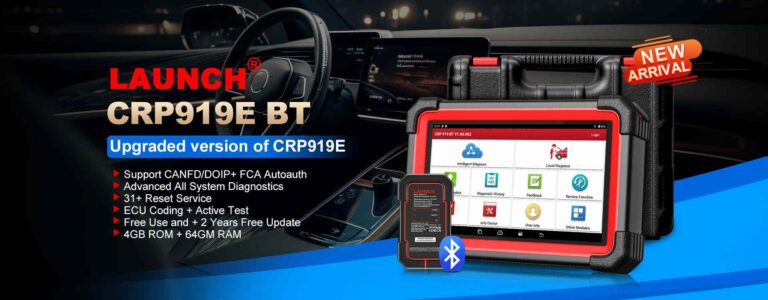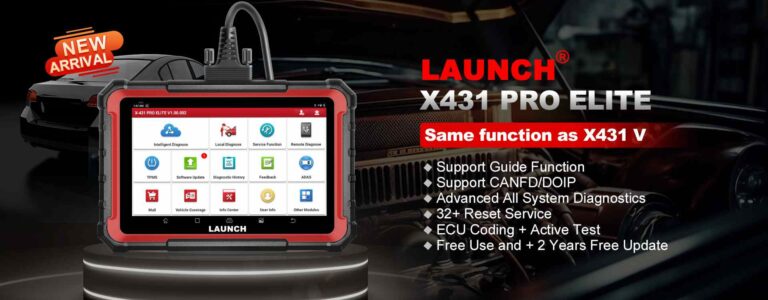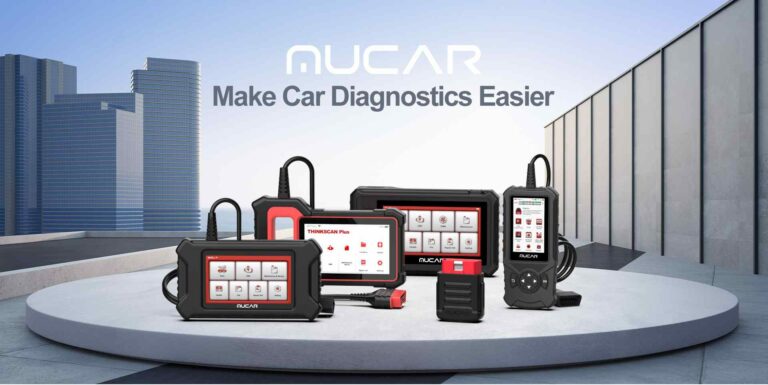Unlock the power of OBD-II scan tools. Our guide empowers you to diagnose your car with confidence for optimal performance.
In automotive diagnostics, an OBD-II scan tool is invaluable for car owners and mechanics.
With the ability to retrieve and interpret diagnostic trouble codes (DTCs), an OBD-II scan tool provides insights into a vehicle’s performance and helps identify potential issues.
In this article, we will guide you in using an OBD-II scan tool to diagnose your car effectively.
What is OBD-II?
OBD-II, or On-Board Diagnostics II, is a standardized system implemented in vehicles produced from 1996 onward. It monitors and reports various aspects of a vehicle’s performance, providing valuable diagnostic information.
Basics of Diagnostic Trouble Codes (DTCs)

Diagnostic Trouble Codes, commonly called DTCs, are alphanumeric codes generated by the OBD-II system to indicate specific issues or faults within the vehicle. Each code corresponds to a particular component or system, aiding in the diagnosis of problems.
The Importance of DTCs for Car Diagnostics
DTCs play a crucial role in diagnosing vehicle issues. They provide a starting point for identifying problems and help pinpoint faulty components or systems. Understanding and interpreting DTCs is key to effectively diagnosing and resolving car problems.
Types of OBD-II Scan Tools
Handheld OBD-II Scan Tools

Features and Functionality
Handheld OBD-II scan tools are standalone devices designed for vehicle diagnostics. They typically have a built-in display, buttons for navigation, and a wide range of diagnostic functions.
Pros and Cons
Handheld scan tools offer convenience and portability, allowing users to perform diagnostics without additional devices. However, they may have limited features compared to other types of scan tools.
Bluetooth OBD-II Adapters

Features and Functionality
Bluetooth OBD-II adapters connect to the vehicle’s OBD-II port and wirelessly transmit diagnostic data to a compatible device like a smartphone or tablet. They rely on dedicated apps for displaying and analyzing the data.
Suggested Reading: BLUETOOTH OBD2 SCANNER | LAUNCH SCAN TOOLS
Pros and Cons
Bluetooth adapters provide flexibility by leveraging the computing power of smartphones or tablets. They offer various diagnostic capabilities, but the performance may vary depending on the app.
Smartphone/Tablet OBD-II Apps

Features and Functionality
Smartphone/tablet OBD-II apps utilize the device’s connectivity and computing power to provide diagnostic functions. These apps connect to the vehicle via Bluetooth or Wi-Fi using a compatible OBD-II adapter.
Pros and Cons
OBD-II apps offer convenience and versatility, as they combine the diagnostic capabilities of the adapter with the user-friendly interface of the smartphone or tablet. However, the quality and features of the apps can vary, requiring careful selection.
Preparing to Use an OBD-II Scan Tool

Identifying the OBD-II Port Location
Before connecting the OBD-II scan tool, locate the OBD-II port in your vehicle. The port is typically located under the dashboard, near the steering column, or the driver’s seat.
Connecting the OBD-II Scan Tool to the Vehicle
Wired Connection (Handheld Scan Tools)
For handheld scan tools, connect the provided cable to the OBD-II port in the vehicle. Ensure a secure connection is established.

Wireless Connection (Bluetooth Adapters and Smartphone Apps)
Pair the adapter with your device using Bluetooth settings for Bluetooth adapters and smartphone apps. Follow the manufacturer’s instructions for the specific adapter or app being used.
Powering On the Scan Tool and Initializing the Connection
Power it on once the scan tool is connected according to the manufacturer’s instructions. This initiates the communication between the scan tool and the vehicle’s OBD-II system.
Reading Diagnostic Trouble Codes (DTCs)

Accessing the DTC Menu
Navigate through the scan tool’s menu to access the DTC menu or code reading function. This may involve selecting the “Read Codes” or a similar option.
Interpreting DTCs and Identifying the Faulty Component
Generic vs. Manufacturer-Specific DTCs
DTCs can be generic or manufacturer-specific. Generic codes are standardized and common across all vehicles, while manufacturer-specific codes provide additional details specific to a particular vehicle brand.
Using DTC Databases and Manuals for Interpretation
Refer to DTC databases or repair manuals to interpret the codes. These resources provide descriptions and troubleshooting guidelines for each code, aiding in identifying the faulty component or system.
Additional Diagnostic Functions
Live Data Stream
Monitoring Real-Time Sensor Readings
Utilize the live data stream function to monitor real-time sensor readings. This allows you to observe the behavior of various sensors, helping identify abnormal values or patterns.
Analyzing Sensor Data for Performance Issues
You can detect performance issues such as inconsistent fuel trims, abnormal oxygen sensor readings, and irregular engine parameters by analyzing sensor data. This aids in diagnosing potential problems.

Freeze Frame Data
Understanding the Snapshot of Vehicle Parameters
Freeze frame data captures a snapshot of vehicle parameters when a DTC is triggered. Understanding this data provides context for the occurrence of the fault and aids in diagnosis.
Analyzing Freeze Frame Data for Fault Identification
By analyzing freeze frame data, you can identify specific conditions, such as engine speed, vehicle speed, or coolant temperature, that led to the occurrence of a fault. This information helps narrow down the diagnostic process.
Component Testing
Activating and Testing Specific Vehicle Components
Some scan tools allow the activation and testing of specific vehicle components, such as actuators, relays, or solenoids. This feature helps assess the functionality and response of individual components.
Evaluating Component Performance and Functionality
By testing components, you can evaluate their performance and functionality. This aids in determining whether a component is operating within the expected parameters or requires further inspection or replacement.
Clearing Diagnostic Trouble Codes (DTCs)

Accessing the Clear DTC Menu
Navigate to the clear DTC menu or similar options within the scan tool’s menu. This option lets you clear the stored DTCs from the vehicle’s OBD-II system.
Clearing DTCs and Resetting the Check Engine Light
Select the clear DTC option to initiate the clearing process. This action removes the stored DTCs and resets the check engine light, indicating the issues have been addressed.
Verifying the Successful Clearing of DTCs
After clearing the DTCs, verify that the codes have been successfully cleared by accessing the DTC menu again. Ensure that no new or pending DTCs are displayed.
Advanced Diagnostic Features (If Applicable)

ABS (Anti-lock Braking System) Diagnostics
Reading ABS Codes
Some advanced scan tools can read ABS codes specific to the anti-lock braking system. This allows for the diagnosis of ABS-related issues.
Analyzing ABS Sensor Readings
By accessing ABS sensor readings, you can monitor individual wheel speed sensors and detect abnormalities or inconsistencies, aiding in diagnosing ABS problems.
SRS (Supplemental Restraint System) Diagnostics
Reading SRS Codes
Advanced scan tools may offer SRS diagnostics, allowing reading of SRS codes related to the supplemental restraint system. This helps identify faults within the airbag or seatbelt pre-tensioner systems.
Identifying SRS Component Issues
You can identify specific component issues within the supplemental restraint system by interpreting SRS codes and accessing related data. This aids in the diagnosis and resolution of SRS-related problems.
Tips and Best Practices for Effective Diagnostics

Keeping the Scan Tool and Software Updated
Regularly update the scan tool firmware and associated software to ensure compatibility with the latest vehicle models and improved diagnostic capabilities. Updates often include bug fixes and additional features.
Consulting Repair Manuals and Technical Resources
Refer to repair manuals and technical resources when interpreting DTCs or diagnosing specific problems. These resources provide detailed information and guidance for accurate diagnostics and repairs.
Seeking Professional Assistance when Necessary
If you encounter complex issues or require specialized knowledge, do not hesitate to seek professional assistance. Automotive professionals have the expertise and equipment to perform in-depth diagnostics and repairs.
Conclusion
An OBD-II scan tool is an effective way to diagnose car problems and gain valuable insights into your vehicle’s performance.
By understanding OBD-II, DTCs, and the various scan tools available, you can confidently diagnose issues, read DTCs, analyze live data, and clear codes.
Remember to follow best practices, consult resources, and seek professional help when necessary.
With the power of an OBD-II scan tool in your hands, you can take control of your car’s diagnostics and keep it running smoothly.






